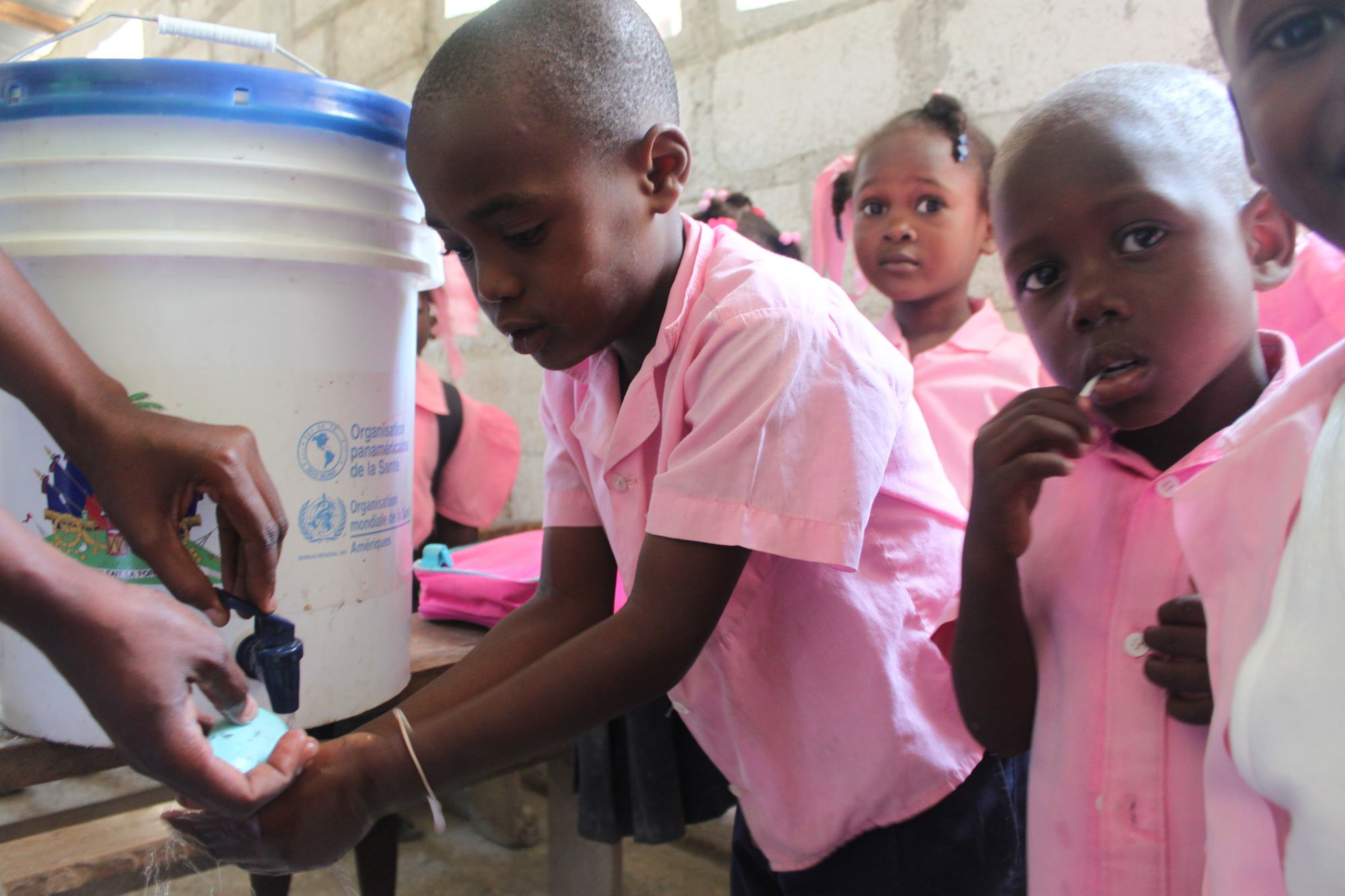
27 July 2016 – “Wash my hands before eating and nursing the baby, wash my hands after relieving myself, use Aquatabs to purify the water…” and so, Sherline Deus lists the steps she must take to protect herself and her children from cholera in the town of Grand Bois, located in in north-eastern Haiti, near the country’s border with the Dominican Republic.
Ms. Deus is not alone in repeating the steps.
She, along with ten other neighbouring households, are part of a so-called ‘sanitary cordon,’ set up as a prophylactic measure by a mobile response team to help prevent cholera from spreading after one of her neighbours fell sick with the disease.
As every suspected case of cholera, Pierre’s case has set in motion the standard rapid response mechanism that was established in Haiti three years ago and has since been applied all over the country with encouraging results.
Such sanitary cordons are just one of the steps taken by the rapid response teams, which are composed of representatives from non-governmental organizations (NGO) and the government, and are supported by the United Nations – particularly the UN Children’s Fund (UNICEF), the World Health Organization (WHO) and its regional presence, the Pan American Health Organization (PAHO) – to facilitate smooth coordination.
Since the outbreak of cholera in Haiti in 2010, Haitian and international efforts have drastically reduced the number of cholera cases and fatalities by almost 90 per cent since they peaked in 2011, which saw Haiti deal with 350,000 cases, according to statistics from the country’s Ministry of Health. In 2015, the number of suspected cases dropped to 36,000.
The UN family in Haiti has supported the Government of Haiti in mobilizing some $307 million for its National Plan for the Elimination of Cholera. Of the $307 million, the UN has directly delivered more than $59 million to implement 291 initiatives for both rapid and longer-term responses to address the root causes of the epidemic. These measures include strengthening water, sanitation and hygiene infrastructures, ensuring access to quality health services, and capacity development in the preventive health sector.
However, cholera remains an emergency in Haiti. In 2016, the Ministry of Health registered 21,661 suspected cholera cases and 200 related deaths from 1 January to 9 July. Funding is needed to maintain the rapid response approach, which has proven effective in saving lives and controlling the epidemic.
“Once we arrive in a location, we first visit the family of the cholera patient. We interview his relatives based on a standard questionnaire concerning issues such as hygiene practices in the household, their usual water point, recent travel of the patient and his family, the patient’s occupation, etc. – the aim is to identify the cause of the outbreak as quickly as possible to avoid further spreading of the disease,” said Brigitte Honore, a 34-year-old Haitian, serving with a mobile response team run by the NGO Oxfam.
Once this evaluation is carried out, specialists like Ms. Honore and her colleagues then start a systematic disinfection of the patient’s house and its immediate surroundings to eliminate any residue of the cholera virus, and prevent other family members or friends from getting sick.
“The last part of our visit is the sensitization. Our aim is to show people how they can protect themselves from cholera with simple measures such as handwashing, water purification, etc.,” said Ms. Honore. “We also provide them with a one-month supply of chlorine, soap and a bucket.”
Before mobile response teams leave, they also administer a dose of antibiotics to all household members, with the aim of establishing a three-day ‘immunity shield’ from bacteria so as to break any transmission chain.

Two boys drinking clean water from a tap. One of the services the UN has improved, include strengthened access to water. Photo: PAHO/ WHO Haiti
The establishment of the ‘sanitary cordon’ follows a similar logic. By applying the described preventive protocol to families residing in the immediate radius of a registered cholera patient, mobile response teams try to isolate the bacteria and protect a patient’s neighbours. After implementing the preventive measures, the teams then continue to search actively for other ailments or suspicious deaths in the area which could indicate the presence of cholera.
A couple of days after the initial visit, mobile response teams return to the homes located within the ‘sanitary cordon’ for follow-up monitoring. This involves testing the household’s drinking water to confirm that it has been treated with chlorine, as well as see how the household is faring with other protective measures.
“More often than not, people know exactly what needs to be done,” said Ms. Honore. “But as soon as the imminent risk of cholera is gone they fall back into their old behaviours, like fetching water from unprotected sources and not purifying their water.”
In the case of this particular case in Grand Bois, the cause of the outbreak seemed to reside in a contaminated water source, according to UNICEF experts. Open defecation is part of local habit and, in particular, during the rainy season it increases the chances of faeces being flushed into open water sources such as rivers and unprotected wells.
“More often than not, people know exactly what needs to be done,” said Ms. Honore.
In relation to this, the findings of a joint monitoring programme for water supply and sanitation, carried out jointly by UNICEF and WHO, estimated that in 2012 only 62 per cent of Haitians had access to improved drinking water and only 24 per cent of the population have access to non-shared toilets – and that these figures plummeted to 47 per cent and 16 per cent in rural areas, such as Grand Bois.
“Among the different actions the UN can take to support Haiti to respond to cholera, we have found that the rapid response and sensitization have proven themselves to be two key pillars for efforts to save lives”, said the UN Resident and Humanitarian Coordinator for Haiti, Mourad Wahba.
But the rapid response is just one aspect of the UN actions supporting Haiti in the fight against cholera, according to Mr. Wahba, who emphasized that in order to continue implementing the best rapid and long-term responses, “predictable funding is required for the next five years.”
“Let me say that funding is very visible,” he added. “It goes to two main areas, one is for the provision of rapid responses, which I believe are important to contain the spread of cholera but, more importantly and for the longer-term, for the provision of water and sanitation, which is important to contain cholera, and will also have health benefits for the whole population.”
[Source:- UN news Centre]





